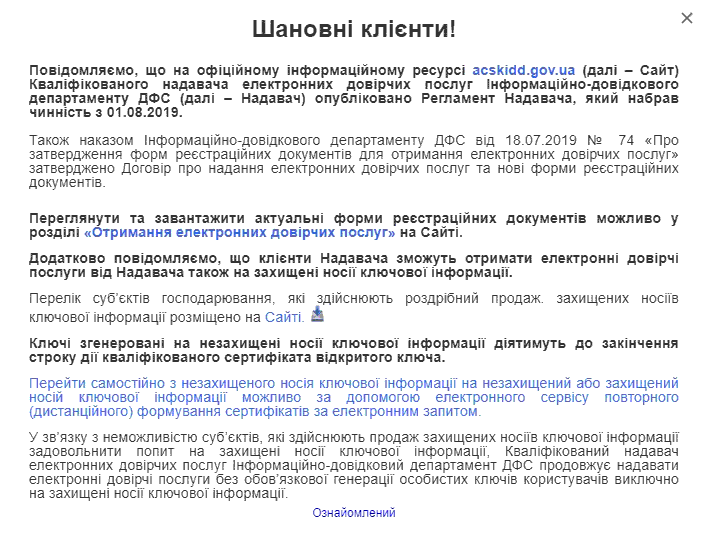WHAT TO START WITH?
Since last year the electronic document management topic in Ukraine is one of centric ones in the finance management environment (it is raised at nearly each business forum). The progress locomotives are, oddly enough, first, the state with its electronic tax reporting system, electronic state procurement and governmental services, and recently also various government bodies with governmental electronic document management. Second, the companies that provide electronic digital signature services, as well as the providers of enterprise management systems (ERPs) proposing electronic documents as a built-in functionality. Third, the country e-commerce leaders. However, for some reason large and medium-sized companies are not hurrying to enjoy the advantages of this definite “benefit of civilization”. As in the case of any early innovation, the e-doc solution raises quite many concerns and precaution. Despite the benefits, which are very well understood, including, at least but not limited to:
- business acceleration due to a significant document exchange time reduction: in signing contracts, executing business transactions and signing transaction supporting documentation
- accounting document processing time reduction, as well as source document error prevention, and, therefore, acceleration of financial period close and availability of real-time accounting data
- reducing costs on mailing, paper and everything related to it (including related IT infrastructure)
- unambiguously overall positive environmental impact, increasing the image of a company caring about the environment
The internal drivers of a company electronic document management are most often finance guys, struggling to squeeze out the utmost functionality from ERPs and highest possible efficiency from accounting teams. Quite often the initiators are lawyers, but in this case the solution is often quite simplified: legal contracts are signed electronically, and accounting team continue to process papers. Company CEOs visit business forums, where online electronic document management service providers sales guys enthusiastically describe the benefits of business acceleration with their business solutions. In reality, heads of departments of a company cannot even imagine how to work with such solutions: what documents how and where to sign, how to change and organize documents workflow, how to persuade business counterparties to use the same tools etc. Moreover, the various solutions present in a market, as a rule, cannot work with each other.
Even if a company has already decided to implement electronic document management for commercial and finance operations, a part of the company’s employees is always inclined to maintain bureaucracy, express skepticism, fear or rejection of innovation. At every step one would have dozens of questions to be addressed: what kind of electronic signatures and stamps are those, how to handle them, how to manage who what kind of signature has, whom to give, whom not to give, what to do with powers-of-attorney, what risks, what if there is a tax audit, what if our documents are stored on an external “cloud” server and someone gets access to the data, and what if we need to sign a document “retroactively” etc. As a result, projects are stopped only because one emphasizes the growing complexities instead of the potential clarities, lacking to understand a next simplest step or, in plain words…
An elephant is always best “eaten in parts”: better divide the entire transformation process into simple and more achievable by complexity stages:
- Stage 1. Replacement of paper documents with electronic ones
- Stage 2. Implement counterparties document management automation tools
- Stage 3. Optimize and simplify business processes
- Stage 4. Integrate document management into your ERP
STAGE 1. REPLACEMENT OF PAPER DOCUMENT WITH ELECTORNIC ONES
Let electronic documents first circulate in parallel with paper ones by the choice of a counterparty. This was a step the other countries began with, first having introduced the PDF-documents exchange via e-mail, and then the electronic signatures attached to those PDFs. By the way, be aware that the electronic signature standards of different countries are not compatible with each other today (except within the EU). Thus, it is not possible yet to sign documents electronically using a single approach between Ukrainian and foreign counterparts, and the paper documents should still be used.
At this stage, I would propose the following steps:
1. Define a list of documents that you will draw up and sign electronically
To implement it, simulate new business processes by replacing paper documents with electronic ones. First, those should be the key commercially and legally significant ones: contracts, invoices, statements of work performed / services rendered and alike that accelerate the core business processes of a company (i.e. purchases and sales). Minor documents would often be less critical, and could be sent as a plain file or a scan-copy via e-mail.
2. Determine who and what can sign in the company
Every company should elaborate and approve (as an order of a general manager) a delegation of authority (DoA) matrix: who, what and on what amounts can approve/sign within a company. A company may use 2 options in delegating the authority to sign legal contracts: 1) when only few top-managers have the right to sign legal contracts (e.g. a CFO or a Chief Legal Officer, as it is sometimes in EU companies) or 2) to all managers within their responsibility areas and of contract amount limits.
A DoA must be enacted with individual powers-of-attorney (PoA) for each authorized employee. A legal department should issue a general guideline governing PoAs. In addition, a company should determine how PoAs circulate electronically. Particularly, a company might opt to issue general or one-time/periodic PoAs. It is better to refuse from one-time PoAs in favor of a longer-term or periodic PoAs (one-time PoAs for goods receipts have not been mandatory in Ukraine for quite a long time already).
If a company decides to apply general PoAs, I would recommend publishing their electronic copies on a company’s website on a special page. Herewith, all company contracts may be referenced to this web page regarding the PoAs of company representatives signing the contractual documents of company’s behalf.
Bear in mind an electronic document specific feature: it cannot be canceled and/or rejected/deleted. Instead, a separate cancelling/amending electronic document must be issued and signed by the relevant authorized persons. The errors in electronic documents of two or more counterparties are corrected in a similar way: all counterparties should sign a new electronic document to correct the error or cancel the original document. Legal counsels of a company should take care in advance of a standardized cancellation document template.
If the company uses one-time PoAs, it is recommended to issue them for each individual contract. In this case, employee authorities could be managed at a contract level: contract ended – PoA automatically expired. Such PoA cannot be published on a website, as they contain confidential commercial information. Therefore, they are given to employees, who, in turn, manually forward them to counterparty representatives. To strengthen the internal control even further, one-time per-contract PoAs may be issued for a limited expiration period of 2-3 months. In the latter case employees would have to apply to a finance or legal service to renew them periodically.
At this stage a legal service should only prepare drafts of PoAs to be enforced at the next stage.
Sometimes a company may take an approach when contractual documents (e.g. delivery notes, statements on services rendered) must be signed by certain finance employees (after checking them for compliance with the contract etc.). In this case, the documents shall be sent to those employees for signature, and those employees should have a general PoA.
Should a company have a legal seal (as a rule, most Ukrainian companies still have it), the electronic seal is usually kept by finance department (for signing statutory and tax submissions). Thus, this department is vested control function for any outgoing electronic document and is obliged to save such document to a specific electronic registry (a network folder) so that a company could monitor its legal obligations. Under such setup all contracts should include a clause that electronic documents are considered valid only after embedding an electronic seal.
3. Create an internal electronic digital signature (EDS) management service
After employee authorities are fixed, a company should create a guideline on using electronic digital signatures (EDS) (see the guideline for state institutions).
Particularly, it is recommended to create an internal EDS management service, which may be based on an existing department: internal financial, legal or HR service. The EDS service should incorporate at least two employees: a key executive and a backup. The service should ensure:
- obtaining EDS by authorized employees
- recalling (replacing) EDS in case of its loss, employee dismissal or move in a position
- inacting, monitoring and cancelling employee PoAs (including placement to a website)
- training employees on EDS
- other related tasks
Worth mentioning that currently almost every company in Ukraine already has at least three EDSs: one of a general manager, one of a chief accountant and one as company seal. These EDSs are used by accountants to file statutory and tax reporting with controlling authorities. Usually these EDSs are stored on an unsecured medium (as an ordinary file) and the accountants know their passwords that creates certain financial risks for a company. Hence, following the introduction of EDS guideline, the general manager´s EDS should be withdrawn from an accounting team (by canceling the existing general manager’s EDS and issuing a new one with the manager’s personal participation and facilitating this process). Another manager (deputy general manager, CFO or financial manager), who is actually responsible for compiling and submitting tax returns, should be granted a new EDS for that purpose with a respecting notification to a tax authority (required as per clause 11 of section III of Order No. 557).
After re-issuing the general manager’s EDS, it is necessary to put into circulation the new electronic PoAs for other employees, which are prepared in advance.
Employees must receive their EDSs on their own (setting unique and confidential passwords) using free tax office service closest to workplace, whilst a company should facilitate the required documentation.
Until the company chooses the appropriate online EDS service (next stage), the employees should be trained to use the EDS services (both signing with EDS and verifying counterparties documents) through the Ministry of Justice website.
It is advisable to use an embedded EDS file format, when the EDS is incorporated directly into a signed file and the output file format is not changed (.PDF with EDS = .P7S). This is convenient as fewer files need to be stored. However, a company should be prepared that counterparties sign/provide the documents another way: as a .ZIP-archive file with the attached EDS. It may happen if a counterparty signs a document through one of 3rd party online services. Furthermore, a counterparty may require you to provide a document in a .ZIP format for further signing through an online service. Therefore you must be prepared to work with any electronic document file format. For example, “Document.Online” works only with .P7S, and “Vchasno” – only with .ZIP.
At this stage, employees would be prepared to ask contractors to sign documents electronically.
One should paid attention to an EDS storage form, given the following:
Currently, almost all Ukrainian companies use EDSs in an unprotected form (as a plain computer file), while the current Ukrainian legislation requires to use EDS only on secured media (the “tokens”). The difference between a “token” and a file-like EDS is that 1) a “token” is a physical medium (like a flash drive), but 2) the EDS cannot be withdrawn from it (the e-docs are signed inside the “token”) and 3) it blocks after 7 incorrect password attempts, thus, preventing “token” hacking. The Law of Ukraine assumes that EDSs issued earlier November 8, 2018 may still be used until their expiration date within no more than 2 years after the Law had come to effect. From a formal point of view this period ends on November 8, 2019
(paragraph 5 of Section VII of Law No. 2155-VIII). Since then all the companies are required to have EDSs on secured “tokens”, and the unsecured EDSs may be invalidated and no longer be accepted as a n EDS. However, the old EDS validity period expiration is not widely announced currently. The State Fiscal Service warns taxpayers with the following message, giving a thought of that this period will be likely extended further (the text in Ukrainian):
4. Update/amend the contracts with customers and vendors
At the next stage, company’s lawyers should elaborate the renewed contract provisions so that the EDSs could be widely used for signing contract-related documents. Particularly, including the following:
- documents, which may be signed using EDS (contracts, powers-of-attorney, annexes, invoices, delivery notes, statements on acceptance, shipping notes etc.)
- issuing and exchanging powers-of-attorney (general PoAs through a company’s website – for sales, one-time PoAs for a contract – for purchases)
- the electronic document format (.ZIP or .P7S) and other provisions arising from application of an EDS (for more details see this video)
In this regard, one should note an important detail about EDS: should the counterparties have already begun execution of an unsigned contract – it is impossible to sign it digitally “retroactively”. Similarly, it regards any source accounting document (statement, invoice, note etc.). In this regard, it is recommended to include a clause to contracts that that source documents shall be considered valid after they are signed, however, starting from a preparation date (as indicated in a document header) regardless of the signing date. And as regards the contracts: to use the clause 3 of Article 631 of the Civil Code by including a clause that the contracts shall come into force after signing, but are applied to counterparties relations arising since the date of execution beginning (as indicated in a contract preamble).
If you wish to accelerate the transition as much as possible: provide pleasant “bonuses” to counterparties, switching to electronic document management (customers discounts, strict supply tender conditions, accelerated payment terms for vendors etc.)
5. Organize internal services to work with electronic documents (similarly as with paper ones)
For example, legal counsels and the finance department should start keeping a register of the electronic contracts and annexes, and the requirements to its quality should increase. Accounting teams should start collecting electronic documents to network folders in a way as they were dealing before with physical registers. Each electronic document must be appropriately named / numbered / classified /stored or recorded into a corresponding electronic register.
Ideally, a company should have (update) a internal guideline (policy) on document storage / retention, regarding both paper and electronic documents.
You would need less than a month to carry out steps 1-3, and about 1-2 months to carry out similar transformation with the main contractors.
If you share this article with your counterparts, it will significantly accelerate your progress!
I provide just a few important comments on further “digitalization” stages below.
STAGE 2. IMPLEMENT COUNTERPARTIES DOCUMENT MANAGEMENT AUTOMATION TOOLS
One should note, that the available online EDS services offered today are certainly useful, but they all have a significant drawback: they are not integrated with each other. Until the service providers mature enough to integrate with each other you should be prepared to use the services of several of them at once. Here is a list of existing (and legitimate!) service providers.
It might be a “M.E.Doc” service, given the fact that 90% of companies currently use it to file statutory and tax reporting (however, due to the same reason accountants are not willing to extend its use to electronic document management – so that not to give other employees access to “their” system). It may be worth using one of products of an integrated “Ptah” service (as well covering “M.E.Doc”), and also “Vchasno”, which seem to be a leader in SMB users. At the same time, middle and large companies often prefer “Document.Online” providing more functionality for internal document management. Regardless of that, the above services are now developing very fast, and their competitive advantages distribution may shortly change. Choose a service that is preferred by most of your counterparties.
Large companies often raise one more important issue: commercial and personal data confidentiality while keeping documents in an online service. A remedy to this issue highly depends on internal policies of each particular company and its vision about digital risks. However, ultimately any company needs to keep all its documents in an internal archive. I would recommend saving documents to a central archive immediately after its completing, and not follow the way proposed by those online services (i.e. periodically download archive from an online service to present to a tax inspection etc.). The recommended approach also addresses an issue of document long-term storage: using online service may be discontinued at any time, while no service guarantees keeping documents in an electronic archive during their lifetime. Whilst, as a company is supposed to use several online services at a time, this approach turns out to be the only possible alternative.
Thus, in order to cover company data confidentiality issue, it is advisable to adopt a policy of storing all electronic documents in an internal archive and their immediate deletion from an online service thereafter. The only remaining risk might be data leakage at counterparties’ side, which, however, beyond company’s control.
STAGE 3. OPTIMIZE AND SIMPLIFY BUSINESS PROCESSES
After having worked with electronic documents for a while, you might encounter some good ideas how to simplify your processes further. There is no a single recipe for all: every company will have different business processes.
STAGE 4. INTEGRATE DOCUMENT MANAGEMENT INTO YOUR ERP
Surely, a dream of any finance guy or an advanced leader would be to integrate all the business processes into a single ERP. Both 1C and SAP to a certain extent allow automating electronic document management, but this might not be possible, appropriate or reasonable for all types of documents. The major attention should be paid to key business processes automation only: sales of goods and/or services. A significant progress for any Ukrainian company would be even a possibility to send digitally-signed electronic documents (invoices, notes, statements, shipment notes etc.) to customers immediately from ERP.
Regarding procurement, it is recommended as soon as possible to start obtaining vendors documents not only in a printable format (a .PDF), but also as a an electronic file (.XLS / .XLSX or .XML). Here, .ZIP-format electronic documents may well fly: one may transfer both a .PDF (needed for courts and tax inspectorate) and an .XML version in a single .ZIP-file. The electronic file should be automatically uploaded to ERP and verified with its hard copy. The file format and import process should be pre-configured in ERP. Using electronic files may also facilitate generate derivative accounting documents (e.g. statements on materials write-off based on vendor invoices and delivery notes).
As a result of the above measures, the accounting team processing time should reduce to just a couple of minutes per document, and it should entail reduction in accounting personnel, as well personnel and office infrastructure costs.







